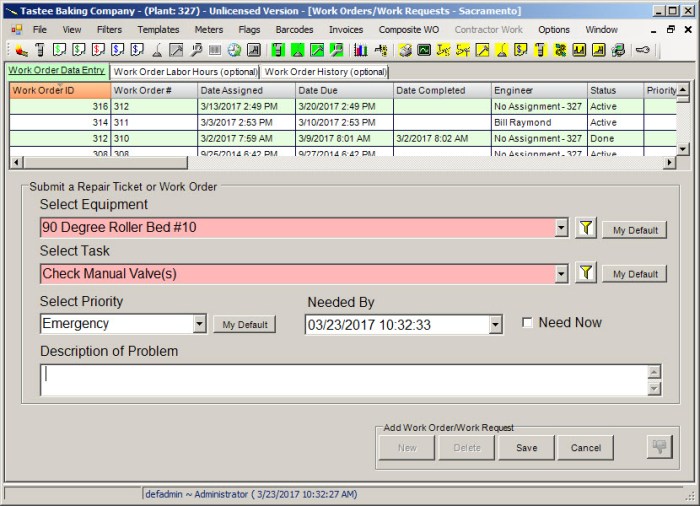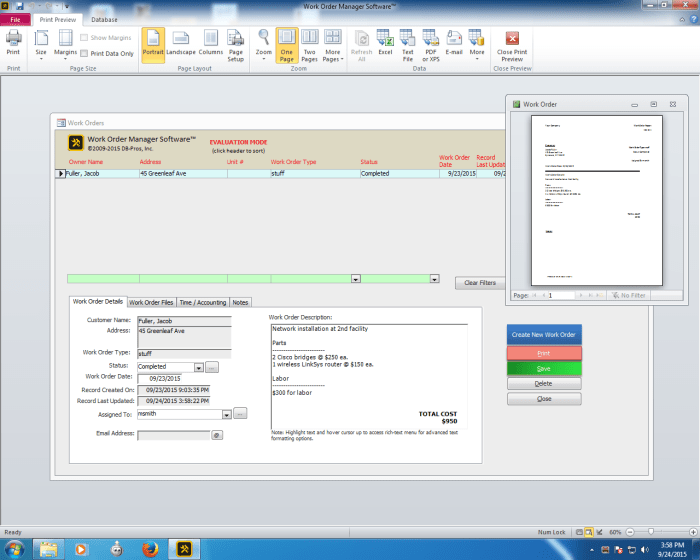Work order dispatch software revolutionizes how businesses manage and allocate tasks. This sophisticated technology streamlines workflows, improves communication, and ultimately boosts operational efficiency. From assigning jobs to tracking progress, these systems offer a centralized platform for managing the entire work order lifecycle, ensuring smoother operations and enhanced customer satisfaction. Efficient resource allocation, real-time tracking, and automated reporting are just some of the key benefits driving widespread adoption across various industries.
By automating manual processes and providing valuable data insights, work order dispatch software empowers businesses to make data-driven decisions, optimize resource utilization, and ultimately achieve significant cost savings. The ability to quickly respond to customer requests, track technician performance, and generate detailed reports contributes to a more responsive and efficient service delivery model. This ultimately leads to increased profitability and a competitive edge in today’s dynamic market.
In today’s fast-paced business environment, efficiency is paramount. For businesses relying on field service technicians, efficient work order management is crucial for profitability and customer satisfaction. This is where work order dispatch software steps in, revolutionizing how companies manage, assign, and track field service operations. This comprehensive guide will explore the intricacies of work order dispatch software, its key features, benefits, and how it can significantly improve your bottom line.
Understanding Work Order Dispatch Software: A Comprehensive Overview
Work order dispatch software is a sophisticated system designed to automate and optimize the entire work order lifecycle, from initial request to final completion. It acts as a central hub, connecting dispatchers, technicians, and customers, ensuring seamless communication and efficient resource allocation. The software streamlines processes, minimizes administrative overhead, and provides valuable data-driven insights for informed decision-making. This ultimately translates to improved customer service, reduced operational costs, and increased revenue.
Core Features of Effective Work Order Dispatch Software
- Work Order Creation and Management: Efficiently create, schedule, prioritize, and manage work orders with detailed information including customer details, service requests, assets involved, and assigned technicians.
- Automated Dispatching: Intelligent algorithms automatically assign work orders to the most appropriate technician based on factors like skills, location, availability, and service type. This minimizes travel time and optimizes technician schedules.
- Real-time Tracking and Monitoring: Monitor technician location, progress, and status in real-time, providing valuable insights into operational efficiency and enabling proactive management of potential delays.
- Mobile Accessibility: Empower technicians with mobile access to work orders, customer information, and communication tools, enabling them to work efficiently in the field.
- Inventory Management: Track inventory levels, assign parts to work orders, and receive real-time alerts for low stock, ensuring technicians always have the necessary resources.
- Customer Communication: Facilitate seamless communication between dispatchers, technicians, and customers through integrated messaging, email, and SMS notifications, keeping everyone informed throughout the process.
- Reporting and Analytics: Generate comprehensive reports and analyze key performance indicators (KPIs) to identify areas for improvement, optimize resource allocation, and track overall operational efficiency. This includes metrics such as first-time fix rates, average service time, and customer satisfaction scores.
- Integration Capabilities: Seamlessly integrate with existing CRM systems, accounting software, and other business applications for a unified and streamlined workflow.
- Scheduling and Optimization: Advanced scheduling algorithms optimize technician routes, minimizing travel time and maximizing service appointments within a given timeframe. This often involves features like route optimization and automated scheduling.
- Service Level Agreements (SLAs): Track and manage service level agreements, ensuring timely completion of work orders and maintaining high levels of customer satisfaction.
Benefits of Implementing Work Order Dispatch Software
The benefits of adopting work order dispatch software extend far beyond simply automating tasks. It leads to significant improvements across various aspects of a field service business:
- Increased Efficiency and Productivity: Automation streamlines workflows, reduces manual tasks, and optimizes resource allocation, leading to significant improvements in overall efficiency and productivity.
- Improved Customer Satisfaction: Faster response times, improved communication, and efficient service delivery enhance customer satisfaction and loyalty.
- Reduced Operational Costs: Optimized routing, reduced travel time, and minimized administrative overhead contribute to significant cost savings.
- Better Resource Allocation: Intelligent dispatching ensures that the right technician is assigned to the right job at the right time, maximizing resource utilization.
- Enhanced Data-Driven Decision Making: Real-time data and comprehensive reporting provide valuable insights for informed decision-making and continuous improvement.
- Improved Technician Performance: Mobile access to work orders, customer information, and communication tools empowers technicians and improves their performance.
- Increased Revenue: Improved efficiency, customer satisfaction, and reduced costs contribute to increased revenue and profitability.
Choosing the Right Work Order Dispatch Software
Selecting the right work order dispatch software requires careful consideration of several factors:
- Business Needs and Size: Choose a solution that aligns with your specific business needs and scales effectively as your business grows.
- Features and Functionality: Prioritize features that are essential to your operations, such as mobile accessibility, real-time tracking, and reporting capabilities.
- Integration Capabilities: Ensure the software integrates seamlessly with your existing systems to avoid data silos and streamline workflows.
- Cost and Pricing Model: Consider the total cost of ownership, including licensing fees, implementation costs, and ongoing maintenance.
- Vendor Support and Training: Choose a vendor that provides excellent customer support and comprehensive training to ensure a smooth implementation and ongoing operation.
- Scalability and Flexibility: Ensure the software can adapt to your future needs and accommodate growth.
Frequently Asked Questions (FAQ): Work Order Dispatch Software
- Q: What is the difference between work order dispatch software and field service management (FSM) software?
A: While closely related, FSM software is a broader term encompassing work order dispatch as a core function. FSM typically includes additional features like inventory management, customer relationship management (CRM), and advanced reporting and analytics. - Q: How much does work order dispatch software cost?
A: The cost varies widely depending on the features, functionality, and vendor. Pricing models typically include subscription-based fees, per-user licenses, or a combination of both. - Q: How long does it take to implement work order dispatch software?
A: Implementation time depends on the complexity of the software and the size of your business. It can range from a few weeks to several months. - Q: Can work order dispatch software integrate with my existing systems?
A: Many work order dispatch solutions offer integration capabilities with various systems, including CRM, accounting software, and inventory management systems. - Q: What are the key performance indicators (KPIs) to track with work order dispatch software?
A: Key KPIs include first-time fix rates, average service time, customer satisfaction scores, technician utilization rates, and overall operational costs.
Conclusion
Work order dispatch software is an invaluable tool for businesses relying on field service technicians. By streamlining operations, improving communication, and providing valuable data-driven insights, it significantly enhances efficiency, customer satisfaction, and profitability. Investing in the right work order dispatch solution can be a game-changer for your business, leading to a more streamlined, efficient, and profitable future.
References
While specific software vendors are avoided to maintain neutrality, general information on field service management and related topics can be found on reputable sites like:
Call to Action
Ready to optimize your field service operations and experience the benefits of work order dispatch software? Contact us today for a free consultation and let us help you find the perfect solution for your business needs!
In conclusion, implementing work order dispatch software offers a significant opportunity for businesses to optimize their operations and gain a competitive advantage. The benefits extend beyond simple task management, encompassing improved communication, enhanced resource allocation, and valuable data-driven insights. By embracing this technology, businesses can streamline their workflows, improve customer satisfaction, and ultimately achieve greater efficiency and profitability. The strategic implementation of such software is a crucial step towards building a more responsive and efficient organization.

Source: cmms.org
Helpful Answers
What are the key features of work order dispatch software?
Key features typically include job scheduling, technician dispatch, real-time tracking, automated reporting, inventory management, and customer communication tools.
How much does work order dispatch software cost?
Pricing varies greatly depending on the features, scale, and provider. Expect a range from subscription-based models to one-time purchases with varying levels of support and customization.
What industries benefit most from work order dispatch software?
Industries like field service, HVAC, plumbing, electrical, and others relying on mobile technicians benefit greatly from improved dispatch and communication capabilities.

Source: db-pros.com
How can I choose the right work order dispatch software for my business?
Consider your specific needs, budget, and the size of your operation. Look for software with scalability, integration capabilities, and robust reporting features.
Can work order dispatch software integrate with my existing systems?
Many systems offer integrations with CRM, accounting, and other business applications. Check for API capabilities and compatibility with your current tech stack.